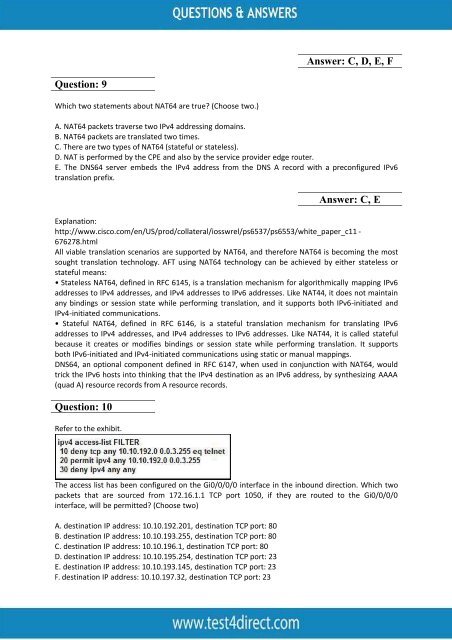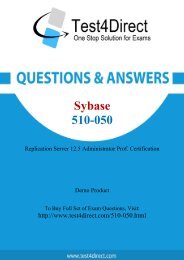640-878 Latest Exam BrainDumps
Test4Direct provides latest PDF questions of Cisco 640-878 exam. You have an opportunity to pass the Cisco 640-878 exam in one go. Test4Direct is most accurate source to prepare Cisco 640-878 exam as your success will become site’s responsibility after purchasing 640-878 exam product. There are also lots of discounts and promotion offers that you can avail. Let’s try a free demo http://www.test4direct.com/640-878.html
Test4Direct provides latest PDF questions of Cisco 640-878 exam. You have an opportunity to pass the Cisco 640-878 exam in one go. Test4Direct is most accurate source to prepare Cisco 640-878 exam as your success will become site’s responsibility after purchasing 640-878 exam product. There are also lots of discounts and promotion offers that you can avail. Let’s try a free demo http://www.test4direct.com/640-878.html
You also want an ePaper? Increase the reach of your titles
YUMPU automatically turns print PDFs into web optimized ePapers that Google loves.
Answer: C, D, E, F<br />
Question: 9<br />
Which two statements about NAT64 are true? (Choose two.)<br />
A. NAT64 packets traverse two IPv4 addressing domains.<br />
B. NAT64 packets are translated two times.<br />
C. There are two types of NAT64 (stateful or stateless).<br />
D. NAT is performed by the CPE and also by the service provider edge router.<br />
E. The DNS64 server embeds the IPv4 address from the DNS A record with a preconfigured IPv6<br />
translation prefix.<br />
Question: 10<br />
Answer: C, E<br />
Explanation:<br />
http://www.cisco.com/en/US/prod/collateral/iosswrel/ps6537/ps6553/white_paper_c11 -<br />
676278.html<br />
All viable translation scenarios are supported by NAT64, and therefore NAT64 is becoming the most<br />
sought translation technology. AFT using NAT64 technology can be achieved by either stateless or<br />
stateful means:<br />
• Stateless NAT64, defined in RFC 6145, is a translation mechanism for algorithmically mapping IPv6<br />
addresses to IPv4 addresses, and IPv4 addresses to IPv6 addresses. Like NAT44, it does not maintain<br />
any bindings or session state while performing translation, and it supports both IPv6-initiated and<br />
IPv4-initiated communications.<br />
• Stateful NAT64, defined in RFC 6146, is a stateful translation mechanism for translating IPv6<br />
addresses to IPv4 addresses, and IPv4 addresses to IPv6 addresses. Like NAT44, it is called stateful<br />
because it creates or modifies bindings or session state while performing translation. It supports<br />
both IPv6-initiated and IPv4-initiated communications using static or manual mappings.<br />
DNS64, an optional component defined in RFC 6147, when used in conjunction with NAT64, would<br />
trick the IPv6 hosts into thinking that the IPv4 destination as an IPv6 address, by synthesizing AAAA<br />
(quad A) resource records from A resource records.<br />
Refer to the exhibit.<br />
The access list has been configured on the Gi0/0/0/0 interface in the inbound direction. Which two<br />
packets that are sourced from 172.16.1.1 TCP port 1050, if they are routed to the Gi0/0/0/0<br />
interface, will be permitted? (Choose two)<br />
A. destination IP address: 10.10.192.201, destination TCP port: 80<br />
B. destination IP address: 10.10.193.255, destination TCP port: 80<br />
C. destination IP address: 10.10.196.1, destination TCP port: 80<br />
D. destination IP address: 10.10.195.254, destination TCP port: 23<br />
E. destination IP address: 10.10.193.145, destination TCP port: 23<br />
F. destination IP address: 10.10.197.32, destination TCP port: 23
















